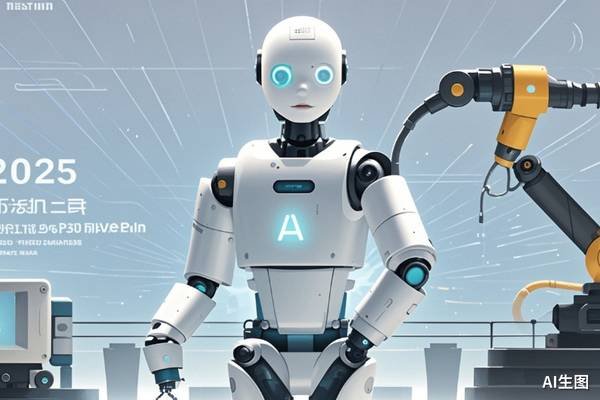In 2025, the deep integration of humanoid robots and artificial intelligence technology is changing the industrial landscape at an unprecedented pace. Against the backdrop of Tesla’s Optimus entering mass production and Huawei increasing its capital investment in its humanoid robot subsidiary to 3.89 billion yuan, the industry has moved from the “concept verification stage” to the “commercialization implementation stage.”
Meanwhile, breakthroughs in large AI model technology have provided humanoid robots with a more powerful “brain,” while humanoid robots offer AI a “body” to interact with the physical world. The coordinated development of the two is opening up a brand – new era of “embodied intelligence.” According to Wind data, in the first half of 2025, the average revenue of the A – share humanoid robot concept sector increased by 9.72% year – on – year, and the average revenue growth rate in the AI application field reached 18.7%, significantly higher than the overall level of A – shares.
This wave of technological innovation has not only attracted high attention from the capital market but also begun to release real value in scenarios such as industrial manufacturing, healthcare, and household services. Can the rapid implementation of AI and humanoid robot technologies turn science fiction into reality?
01 AI Applications: From Technological Empowerment to Value Creation
2025 is regarded as a crucial turning point for AI applications to shift from the popularization of technological concepts to in – depth industry integration. IDC data shows that the global AI market size is expected to reach $221.87 billion in 2025, with a compound annual growth rate of approximately 26.2%, and the Chinese market is becoming an important engine for this growth.
Technologically, AI applications are characterized by “full – scale expansion and high – value – added leadership.” In the field of computing infrastructure, ZTE Corporation (000063.SZ)’s liquid – cooled servers and AI servers have become industry benchmarks.
In the area of multimodal content generation, Wondershare Technology Group Co., Ltd. (300624.SZ) achieved AI – native application revenue of 60 million yuan with its Tianmu 2.0 multimodal model, and the number of paying users increased by 200% year – on – year. In the field of industrial digitalization, Taiji Computer Corporation (002368.SZ)’s government big data platform solutions have served more than 30 provinces and municipalities across the country. In terms of enterprise – level intelligent agents, Hand Enterprise Solutions Co., Ltd. (300170.SZ) has launched nearly a hundred mature intelligent agents, with a contract value exceeding 25 million yuan.
With the unremitting efforts of leading enterprises, technological breakthroughs in the industry are particularly significant. Tencent’s Hunyuan TurboS adopts a Transformer – Mamba hybrid architecture, doubling the inference efficiency. When Hong Technology Co., Ltd. (300441.SZ)’s ultra – high – definition video AI processing solution has a market share of 35%. The sales volume of Rokid AI glasses has exceeded one million units, and the average price has dropped below 2,000 yuan, marking the popularization of edge – side AI applications.
Of course, in addition to development, the industry also faces multiple challenges. Firstly, there is the issue of data privacy. An IBM report shows that 16% of data breaches in 2025 involved the use of AI tools. Secondly, there is the risk of algorithmic bias, which may lead to unfair results in financial credit approval and medical diagnosis. Thirdly, regulatory policies are tightening. A cross – border AI enterprise was fined 20 million yuan for non – compliant data transfer overseas, which serves as a warning of the compliance risks in the industry.
Notably, 54% of enterprises still cannot quantify the return on AI investment (according to Deloitte data), indicating that the industry still needs to make breakthroughs in validating commercial value. However, with the deep integration of AI technology and industry know – how, especially in data – intensive fields such as finance and healthcare, AI applications are shifting from “auxiliary tools” to “business partners,” and the path to value creation is becoming increasingly clear.
02 Humanoid Robots: From Technological Verification to Scenario Implementation
If 2024 was the “year of technological breakthrough” for humanoid robots, then 2025 is undoubtedly the “first year of commercialization.” The “Opinions on Deeply Implementing the ‘Artificial Intelligence +’ Initiative” issued by the State Council clearly supports the development of intelligent robots. Beijing has even established a humanoid robot innovation center and released the world’s first “Intelligent Classification Standard for Humanoid Robots,” providing policy support for the industry’s development.
Driven by policy support and the market, all aspects of the humanoid robot industry chain are accelerating their improvement. Among them, significant progress has been made in the localization of core components. The localization rate of harmonic reducers produced by Green Harmonic Drive Systems Co., Ltd. (688017.SH) has reached 25%. In the first half of 2025, its revenue was 251 million yuan, with a gross profit margin of 34.77%. KeLi Sensing Co., Ltd. (603662.SH) has deployed nearly 20 types of robot sensors, and the measurement error of its six – axis force sensor is less than 1%. The company’s revenue in the first half of the year was 685 million yuan, a year – on – year increase of 23.4%. Beit Automotive Co., Ltd. (603009.SH) has achieved a fine – grinding accuracy of ±0.001mm in the field of planetary roller screws. The localization of core components has reduced the BOM cost of the whole machine by 30 – 40%, laying the foundation for commercialization.
Among the whole – machine manufacturers, Estun Automation Co., Ltd. (002747.SZ)’s 31 – degree – of – freedom robot has a 23% market share in the medical exoskeleton field, with revenue of 2.549 billion yuan in the first half of the year. Midea Group Co., Ltd. (000333.SZ), with its combination of “embodied intelligence algorithm + KUKA hardware,” has sent its robots to the Jingzhou factory to participate in standardized operations such as equipment maintenance and material handling. Fourier GR – 3 focuses on household services and plans to enter offline stores in the second half of the year to provide services.
Technologically, the H1 robot of Unitree Robotics has significantly increased its degrees of freedom and enhanced its movement flexibility. Orbbec’s 3D vision sensor can model complex environments, significantly improving accuracy. These technological advancements have initially verified the application value of robots in scenarios such as industrial manufacturing and logistics sorting.
However, despite the progress, the industry still faces significant challenges. Core components such as high – end sensors and high – performance motors still rely on imports. The movement accuracy of robots in complex environments is less than 90%, still falling short of industrial standards. In addition, although some components have been domestically substituted, the unit cost of humanoid robots remains as high as 199,000 yuan, which is unaffordable for most families. As Soochow Securities pointed out, the global sales volume of humanoid robots in 2025 is expected to be less than 30,000 units, still far from large – scale popularization.
03 Integration and Breakthrough: The Commercialization Path of AI + Humanoid Robots
Amid the challenges, the deep integration of humanoid robots and AI technology is becoming the key force to drive the industry forward. On the one hand, large AI models provide humanoid robots with more powerful decision – making capabilities. On the other hand, humanoid robots offer AI a carrier to interact with the physical world. The synergy between the two will open up a closed – loop of “perception – decision – execution.”
In terms of technological integration, large models such as Tencent’s Hunyuan TurboS have doubled the inference efficiency, enabling robots to handle complex tasks more quickly. Multimodal large models have enhanced robots’ ability to understand the environment, allowing them to process multiple types of information such as vision and voice simultaneously. Enterprises such as Huawei and Midea are actively exploring the path of “embodied intelligence,” deeply integrating AI algorithms with robot hardware.
However, to truly enable AI technology and humanoid robots to benefit humanity, the following problems need to be solved. Firstly, the acceleration of domestic substitution of components. Currently, the localization rate of core components for humanoid robots is generally low, with 25% for harmonic reducers, 15% for planetary roller screws, and 10% for six – axis force sensors. With increased policy support and capital investment, it is expected that the localization rate of core components will exceed 50% by 2027. Enterprises such as Green Harmonic Drive Systems and KeLi Sensing are accelerating technological research to support cost reduction in the industry.
Secondly, a breakthrough in large – scale mass production is needed. Goldman Sachs predicts that the compound annual growth rate of global humanoid robot sales from 2025 to 2035 can reach 94%, but this is based on achieving “tens of thousands of units” of mass production. Tesla’s Optimus mass production has set a benchmark for the industry, and domestic manufacturers such as Ubtech Robotics (9880.HK) and Unitree Robotics are also actively deploying. As production volume increases, the scale effect will significantly reduce the unit cost.
Finally, the focus on scenarios and value verification of humanoid robots are crucial. The industrial scenario, with its high degree of standardization and clear ROI, has become the first area for humanoid robots to be implemented. The application of Midea’s robots in the Jingzhou factory has proven their value in scenarios such as equipment maintenance and material handling. In the future, as costs decrease and technology advances, scenarios such as household services and medical rehabilitation will also be gradually expanded.
Looking ahead, the deep integration of humanoid robots and AI applications will give rise to new business models and industrial ecosystems. CITIC Securities believes that 2025 is the year of mass production for humanoid robots, and the industry will enter a period of rapid development. CITIC Construction Investment points out that the main investment line for AI should revolve around “computing power as the foundation, self – controllability as an inevitable trend, and the rise of Agent and B – end applications.”
Although the industry still faces challenges in terms of technological maturity, cost control, data privacy, and ethical regulations, the huge potential shown by humanoid robots and AI applications has gained high – level consensus in the capital market. As Goldman Sachs predicts, by 2035, the global humanoid robot market size is expected to reach $38 billion or even $154 billion.
2025 may be the beginning of a great era that turns science fiction into reality. For investors, paying attention to enterprises with rapid commercialization of large AI models, core component enterprises that have entered the supply chains of Tesla and Ubtech, and whole – machine manufacturers with full – industry – chain capabilities may enable them to share the dividends of this technological wave.
This article is from the WeChat official account “Investor Network – Thinking Finance.” Author: Wu Wei. Republished by 36Kr with permission.










































